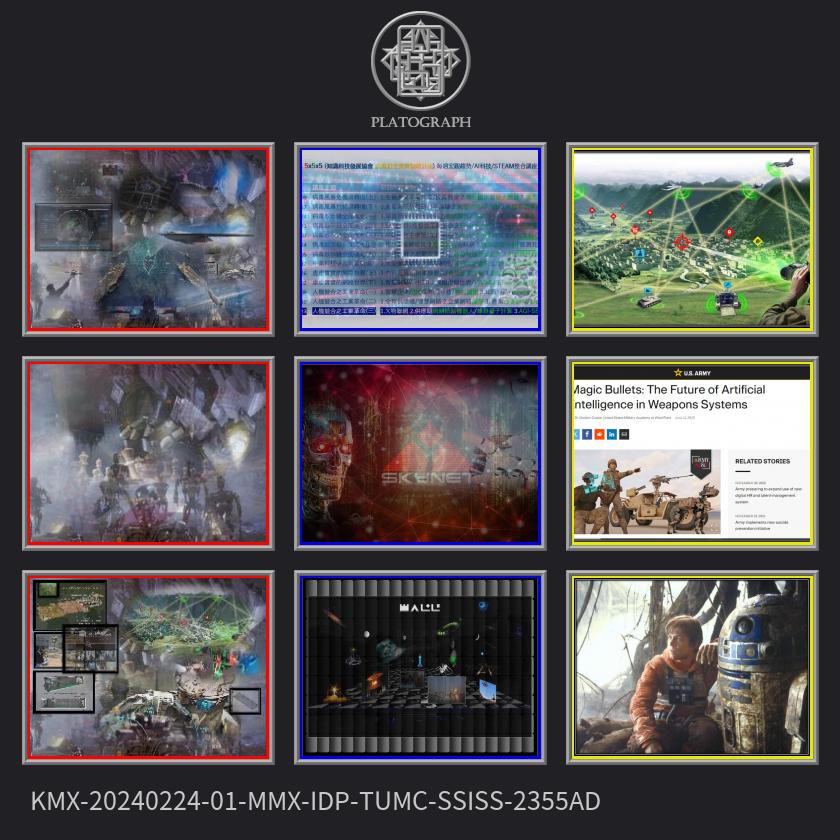
The documents you provided touch on various topics related to the intersection of artificial intelligence, military technology, and futuristic warfare scenarios. Here is a summary of the general discussion based on the document snippets:
1. **AI in Warfare Strategy and Tactics**: The development of AI and related intelligence augmentation technologies is expected to significantly impact strategic and tactical concepts in military operations. This includes enhancing military intelligence capabilities and improving battlefield mobility through the integration of advanced technologies.
2. **Bionic Soldier Enhancements**: Concepts such as turning a dummy shooting-target into a bionic soldier's companion on the battlefield are explored. This involves using advanced sensors, neural interfaces, and drone/robotic integration to create a more capable and efficient fighting force.
3. **Pentagon's Replicator Program**: The Pentagon's Replicator program aims to deploy thousands of attritable/autonomous systems like drone fleets within the next 2 years as part of an AI-integrated initiative. This initiative is seen as a response to China's emphasis on mass warfare strategies.
4. **AI in Weapons Systems**: The United States Army is exploring the use of artificial intelligence in weapons systems, such as automated gun turrets that demonstrate high accuracy in hitting moving targets. This technology is expected to improve military capabilities and effectiveness on the battlefield.
5. **Sensing and IoT Vision**: Honeywell Sensing & IoT is advancing the integration of sensing technologies and the Internet of Things (IoT) to enhance situational awareness and decision-making capabilities in various applications, including military operations.
6. **Sensor-to-Shooter Systems**: Companies like Israeli Rafael Advanced Defense Systems and French Safran Vectronix are developing sensor-to-shooter systems for the U.S. Army. These systems, including the Fire Weaver system, aim to improve target acquisition and engagement for infantry and special forces.
Overall, the documents highlight the rapid advancements in AI, sensing technologies, and military applications, emphasizing the increasing integration of advanced technologies in modern warfare scenarios for enhanced intelligence, efficiency, and combat effectiveness.
您提供的文件涉及與人工智慧、軍事技術和未來戰爭場景交叉相關的各種主題。 以下是基於文件片段的一般性討論摘要: 1. **戰爭戰略和戰術中的人工智慧**:人工智慧和相關情報增強技術的發展預計將顯著影響軍事行動中的戰略和戰術概念。 這包括透過整合先進技術來增強軍事情報能力和提高戰場機動性。 2. **仿生士兵增強**:探索了諸如將虛擬射擊目標變成仿生士兵在戰場上的同伴等概念。 這涉及使用先進的感測器、神經介面和無人機/機器人整合來創建一支更有能力、更有效率的戰鬥部隊。 3. **五角大廈的複製器計畫**:作為人工智慧整合計畫的一部分,五角大廈的複製器計畫旨在在未來兩年內部署數千個可消耗/自主系統,例如無人機機隊。 這項措施被視為對中國強調大規模戰爭戰略的回應。 4. **武器系統中的人工智慧**:美國陸軍正在探索在武器系統中使用人工智慧,例如在擊中移動目標時表現出高精度的自動砲塔。 這項技術有望提高戰場上的軍事能力和有效性。 5. **感測與物聯網願景**:霍尼韋爾感測與物聯網正在推進感測技術與物聯網(IoT) 的集成,以增強各種應用(包括軍事行動)的態勢感知和決策能力。 6. **感測器到射擊系統**:以色列拉斐爾先進防禦系統公司和法國賽峰威創公司等公司正在為美國陸軍開發感測器到射擊系統。 這些系統,包括「Fire Weaver」系統,旨在提高步兵和特種部隊的目標捕獲和交戰能力。 總體而言,這些文件強調了人工智慧、感測技術和軍事應用的快速進步,強調先進技術在現代戰爭場景中的日益融合,以提高情報、效率和戰鬥力。
